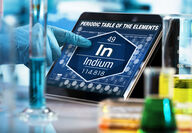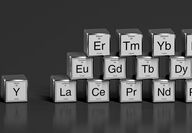Sorted by date Results 1 - 23 of 23

Rhenium is exceptionally resistant to heat and wear, characteristics that make it a vital ingredient in superalloys used in jet and industrial gas turbine engines. "The high-temperature properties of rhenium allow turbine engines to be designed with finer tolerances and operate at temperatures higher than those of engines constructed with other materials," the United States Geological Survey penned in a fact sheet on the critical metal. "These properties allow prolonged engine...

Whether it is the exponential growth in electric vehicles traveling global highways, the massive need for storing energy at solar and wind electrical generating facilities, or cutting the cords on our electronic devices, the world is becoming increasingly dependent on lithium-ion batteries. And this is driving up the demand for cobalt, a critical safety ingredient in the cathodes of these energy storage cells. "Globally, the leading use is in the manufacture of cathode materia...

Cans, cups, roofs, and foil hats are likely the first things that come to mind when thinking about tin – none of which conjure images of a metal that should be considered critical to a modern country like the United States. According to a study carried out by Massachusetts Institute of Technology, however, tin is the metal expected that be most impacted by new technologies. Commissioned by Rio Tinto, the MIT study found that tin beat out more likely technology metals candidate...

Though gold is not considered a metal critical to the United States, this increasingly valuable precious metal could serve as a pathfinder element for several of the other minerals and metals the U.S. Geological Survey deemed critical to America. Selling for roughly US$2,000 per ounce and expected to climb much higher as central banks and governments inject unprecedented amounts of cash into a global economy affected by COVID-19, gold has become an increasingly vital...

Would you consider drinking heavy metals to make your stomach feel better? A serum containing arsenic, cadmium, lead or mercury would only make matters worse and could be deadly. Bismuth, the heaviest of the heavy metals, however, is swigged by millions of indigestion sufferers each year. In fact, stomach remedies such as Pepto-Bismol, along with cosmetic applications, are currently the largest market for bismuth. Being the only non-toxic heavy metal, bismuth is being...

Wind turbines, solar panels, and the batteries that store the electricity these renewable energy sources generate are creating new demands for an array of minerals and metals, many of which are not mined in the United States. Recognizing that mines lie at the front end of America's expanding renewable energy supply chains, federal officials have determined that critical mining projects must be eligible for Fast-41, a program established in 2015 to improve the timeliness,...

Traditionally used to create stronger, lighter, and more durable steels, vanadium is emerging as a potential game changing element in the grid-scale batteries needed to store renewable energy. Known as vanadium redox flow batteries, or VRFBs, this emerging electrical storage technology takes advantage of vanadium's ability to exist in solution in four different oxidation states as electroactive elements, instead of separate elements for the cathode and anode. The amount of ene...

While the United States consumes roughly 5% of the chromite mined globally, none of this chromium mineral comes from domestic mines. Instead, America relies on foreign sources for approximately 72% of its supply and the balance of this vital ingredient in stainless steel and many superalloys comes from recycling. Nearly all America's chromite imports come from one country, South Africa. This heavy reliance on one country, coupled with a dearth of alternatives for this vital...

Considering the global shift to low-carbon energy and electric mobility, copper is the most vital metal not on the United States Geological Survey's list of 35 minerals and metals considered critical to America's economic wellbeing and security. Copper's importance is due to the rapidly emerging electric vehicle, wind turbines and photovoltaic (PV) solar technologies need a lot more copper than the combustion cars and power plants they are replacing. It is estimated that the...

Amongst the rarest of the stable elements on the periodic table and an important ingredient in the emerging thin-film solar panel sector, tellurium embodies what it means to be a metalloid – an element that possesses the properties of both a metal and non-metal – critical to the United States. "Most rocks contain an average of about 3 parts per billion tellurium, making it rarer than the rare earth elements and eight times less abundant than gold," the United States Geo...

Best known for its ability to resist heat and corrosion, antimony is in a wide array of consumer goods – from paints and plastics to batteries and wind turbines. This critical mineral is also used to make clearer glass for smartphones, computer screens and solar panels. "Today, antimony is used in lead-acid storage batteries for backup power and transportation; in chemicals, ceramics, and glass; in flame-retardant materials; and in heat stabilizers and plastics," the U.S. G...

The six platinum group elements – platinum, palladium, rhodium, ruthenium, iridium, and osmium – have one foot firmly planted in the realm of precious metals while the other is firmly established in the industrial sectors. While being amongst the rarest metals on the planet already makes PGE's highly valued for jewelry and bullion, their applications in the automotive, petrochemical, and electronics industries are catalysts that drive the price of these industrious pre...

Niobium and tantalum are nearly identical critical mineral twins with unique personalities that takes them on separate career paths in the defense, energy, high-tech and medical sectors. "The leading use of niobium is in the production of high-strength steel alloys used in pipelines, transportation infrastructure, and structural applications," the United State Geological Survey penned in a 2018 report on the indispensable twins. "Electronic capacitors are the leading use of...

While indium is not part of the everyday lexicon, if you are reading this article on your smartphone, computer or tablet there is a very good chance you are looking at (or more accurately, through) indium right now. This is because indium-tin oxide is used as a transparent conducting film applied to virtually every flat-panel display and touchscreen computer, tablet, and smartphone on the market. This thin coating transforms incoming electrical data into an optical form, a pro...

The United States is heavily dependent on China and other foreign suppliers for its barite, a mineral critical to the petroleum sector. Barite derives from barús, the Ancient Greek word for heavy, owing to an exceptionally high specific gravity for a non-metallic mineral. It is this weight that makes barite a key element to the oil and gas sector and lands the mineral on USGS' critical list. "More than 90% of the barite sold in the United States was used as a weighting agent...

America's supply of tungsten, an extremely durable metal that is vital to a broad range of American industrial sectors, is at high-risk. A recent U.S. Geological Survey assessment to identify which mineral commodities are most at risk to supply disruptions ranked tungsten near the top of the list – alongside rare earth elements, cobalt and graphite, platinum group metals and tungsten. Like many of its neighbors at the top of the mineral commodity supply risk list, much of the...

The United States imported more than 90% of the 1.4 million metric tons of titanium minerals it consumed during 2019. What the mass majority of this critical mineral was used for, however, may come as a surprise. While titanium's lightweight and extreme durability make it an excellent material for aircraft and high-performance sporting equipment, more than 90% of this mineral mined each year is used to impart a stark whiteness to a surprisingly wide variety of consumer goods w...

A semiconductor that will melt in the palm of your hand and has the ability to convert electricity directly into laser light, gallium is a cool critical metal that is an important ingredient in light emitting diodes (LEDs), new generation smartphones, thin-film solar cells, and medical devices. "The development of gallium arsenide as a direct band-gap semiconductor in the 1960s led to what are now some of the most well-known uses of gallium – in feature-rich, a...

While Alaska is regarded as a geological storehouse of minerals critical to the United States, it is less renowned as a current globally significant supplier of germanium, a zinc byproduct metalloid with optical qualities that make it an important ingredient in infrared and fiber-optics, and semiconducting properties being applied to quantum computing, and solar energy systems. "The extensive use of germanium for military and commercial applications has made it a critical...

When you consider the 17 rare earths and six platinum metals individually, more than 50 of the elements on the periodic table have been deemed critical to the economic wellbeing and security of the United States, a list that worries the White House and many policymakers in Washington, D.C. To sort the hierarchy of this expansive list, the U.S. Geological Survey has developed a tool that helps identify which mineral commodities lying at the crux of America's manufacturing...

Due to their vital importance to American manufacturing and the fact that 100% of U.S. supply comes from overseas, primarily China, rare earth elements top the list of minerals and metals deemed critical to the United States. When the U.S. Geological Survey plugged in 52 critical mineral commodities into a recently developed supply risk tool, six rare earth elements – dysprosium (No. 1), yttrium (No. 2), neodymium (No. 3), lanthanum (No. 5), cerium (No. 6) and praseodymium (...

The rapidly accelerating expansion of the electric vehicle and renewable energy sectors is driving enormous new demand for graphite, a major ingredient in lithium-ion batteries. The World Bank forecasts that low-carbon energy technologies, primarily lithium-ion batteries, will require 4.5 million metric tons of graphite per year by 2050, which is about a 500% increase over 2018 levels and a 318% increase over the total graphite produced in 2019. "Graphite demand increases in...

In addition to dealing a major blow to the economy, the COVID-19 pandemic has shined a spotlight on a chink in the United States' economic and security armor – an overreliance on foreign countries for the minerals and metals that lie at the frontend of American supply chains. "The COVID-19 pandemic has shown how delicate our supply chains are and that should be a wakeup call for all of us," Senate Committee on Energy & Natural Resources Chair Lisa Murkowski, R-Alaska, said dur...